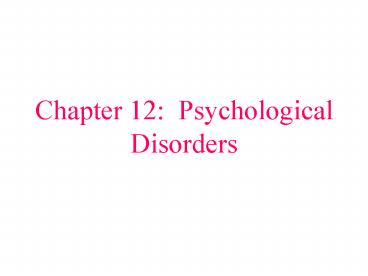Chapter 12: Psychological Disorders - PowerPoint PPT Presentation
1 / 14
Title:
Chapter 12: Psychological Disorders
Description:
Up until 18th century: mental illness was the result of being ... Two types: major depressive disorder & dysthymia. Gender differences: more common in females ... – PowerPoint PPT presentation
Number of Views:45
Avg rating:3.0/5.0
Title: Chapter 12: Psychological Disorders
1
Chapter 12 Psychological Disorders
2
What is a Psychological Disorder?
- Psychologists use the following criteria
- Behavior impairs ones ability to function well
in life - Degree of behavior is extreme
- History of psychological disorders
- Up until 18th century mental illness was the
result of being possessed by the devil - 18th century mentally ill were
institutionalized - 19th century mentally ill were hospitalized
- Late 19th century-now significant advances made
3
What Causes Psychological Disorders?
- The Biological Model-psychological disorders are
caused by physiological malfunctions often
stemming from hereditary factors - The Psychoanalytic Model-psychological disorders
are symbolic expressions of unconscious
conflicts, which can usually be traced to
childhood - The Cognitive-Behavioral Model-psychological
disorders result from learning (both internal and
external) - Diathesis-Stress Model-people biologically
predisposed to a mental disorder will tend to
exhibit that disorder when particularly affected
by stress
4
Prevalence of Psychological Disorders
- Prevalence of Psychological Disorders
- 12-15 in United States
- 6 in Middle East and Africa
- 4 in Asia
- Prevalence of Substance Abuse Disorder
- 6 in United States
- Most common psychological disorders in United
States anxiety disorders, phobias, mood
disorders
5
Mood Disorders
- Mood disorders-disturbances in mood or in
prolonged emotional state - Depression characterized by overwhelming
feelings of sadness loss of interest in things
one normally would enjoy - Two types major depressive disorder dysthymia
- Gender differences more common in females
- Suicide becoming more common among adolescents
and young adults - Mania characterized by euphoric states, extreme
physical activity, excessive talkativeness,
distractedness, and sometimes grandiosity - Bipolar Disorder periods of mania and
depression alternate, sometimes with periods of
normal mood in between
6
What Causes Mood Disorders?
- Most psychologists believe that mood disorders
result from a combination of risk factors
including - Biological Factors
- Psychological Factors
- Social Factors
7
Anxiety Disorders
- Anxiety Disorders-when a person experiences
extreme anxiety but does not know why he/she is
afraid or the anxiety is inappropriate to the
circumstances - Phobias
- Specific Phobia
- Social Phobias
- Agoraphobia
- Panic Disorder
- Other Anxiety Disorders
- Generalized Anxiety Disorder
- Obsessive-Compulsive Disorder
- Acute Stress Disorder
- Posttraumatic Stress Disorder
8
What Causes Anxiety Disorders?
- Again, the development of anxiety disorders seems
to be a combination of factors - Learned Behavior
- Cognitive Factors
- Biological Factors
9
Pychosomatic Somatoform Disorders
- Psychosomatic Disorders-a disorder in which there
is real physical illness that is largely caused
by psychological factors such as stress and
anxiety - Somatoform Disorders-disorders in which there is
an apparent physical illness for which there is
no organic basis - Examples
- Hypochondriasis
- Body Dysmorphic Disorder
10
Dissociative Disorders
- Dissociative Disorders-disorders in which some
aspect of the personality seems separated from
the rest - Rare and not well understood
- Controversial
- Seem to be linked to childhood abuse
11
Sexual Gender-Identity Disorders
- Sexual Dysfunction-the loss or impairment of the
ordinary physical responses of sexual function - Examples include erectile dysfunction, female
sexual arousal disorder, sexual desire disorders,
orgasmic disorders - Paraphilias-the use of unconventional objects or
situations to obtain sexual arousal - Examples include fetishism, voyeurism,
exhibitionsism, transvestic fetishism, sexual
sadism, pedophilia - Gender-Identity Disorders-the desire to become,
or the insistence that one really is, a member of
the other sex
12
Personality Disorders
- Schizoid-person is withdrawn lacks feelings for
others - Paranoid-person is inappropriately suspicious
mistrustful of others - Dependent-person is unable to make choices
decisions independently cannot tolerate being
alone - Avoidant-persons fears of rejection by others
lead to social isolation - Narcissistic-person has an exaggerated sense of
self-importance needs constant admiration - Borderline-characterized by marked instability in
self-image, mood, interpersonal relationships - Antisocial- involves a pattern of violent,
criminal, or unethical exploitative behavior
an inability to feel affection for others
13
Schizophrenic Disorders
- Schizophrenia-severe disorder in which there are
disturbances of thoughts, communications, and
emotions, including delusions and hallucinations - Psychosis-loss of touch with reality
- Hallucinations-false sensory perceptions
- Delusions-false beliefs about reality
- Cause we know that both biological and
environmental factors contribute to the
development of schizophrenia
14
Childhood Disorders
- Attention-Deficit Hyperactivity Disorder (ADHD)
- Trouble focusing, easily distracted, fidgety,
impulsive, constantly in motion - May be related to frontal lobe functioning
- Most often treated with psychostimulants
- Autistic Disorder
- Characterized by lack of social instincts and
strange motor behavior usually associated with
cognitive impairments - Thought to be genetic
- Autistic Spectrum Disorders
- A range of disorders with symptoms associated
with autistic disorder, but perhaps not as severe - One example is Aspergers Syndrome































